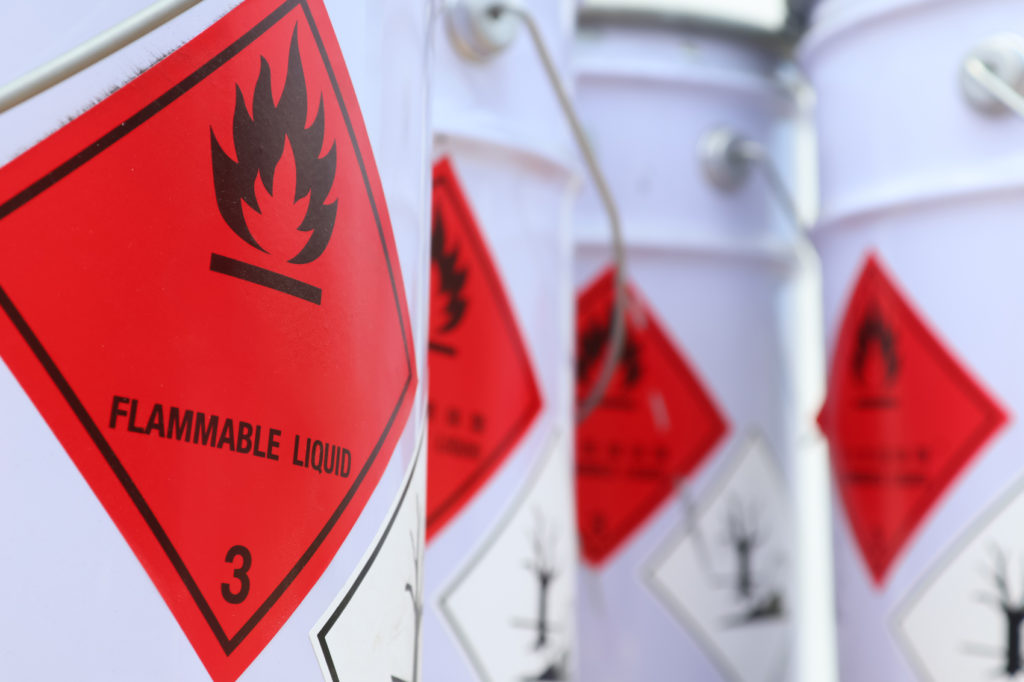Diesel is widely used in many parts of the world. But like any other fuel, it raises concerns about possible health, environmental, and fire safety risks.
Is Diesel Flammable?
Diesel is flammable, according to the United States Occupational Health and Safety Administration (OHSA).
OHSA defines a flammable liquid as any liquid with a flashpoint below 140 °F and a vapor pressure not exceeding 40 pounds per square inch at 100 °F. Common grades of diesel fuel have flash points below 140 °F, so diesel fuel is considered a flammable liquid.
What Is a Flashpoint?
Flashpoint refers to the temperature at which a flammable liquid can evaporate or ignite. It is easier to ignite a fuel that has a lower flashpoint temperature. In short, the higher the flashpoint of the fuel, the less flammable it is.
What Is the Difference Between Flammable and Combustible?
Flammable substances burn at normal working temperatures, while combustible substances need heat to ignite. They also have different flashpoints.

OHSA defines combustible substances as any liquid component with more than 100 °F (37.8 °C) flashpoint.
What Is Diesel Made Of?
The majority of the diesel fuel produced and consumed in America is processed from crude oil in petroleum refineries. A 42-gallon barrel of crude oil yields 11 to 12 gallons of diesel fuel in the United States.
Which Is More Flammable: Diesel or Gasoline?
Diesel is less flammable than gasoline. It cannot be ignited in a vehicle without extreme pressure or a long-lasting flame. On the other hand, a burning match doesn’t have to touch a gasoline pool for it to ignite. The vapors that the gas releases can react to the heat immediately.
The flashpoint of gasoline is approximately -49 °F (or -45 °C). This can vary depending on factors like the fuel’s composition. Despite this, gasoline is more dependable as a combustible fuel and simpler to ignite compared to other fuels like kerosene. It’s why many automakers prefer it over other fuels.
Meanwhile, the flashpoint of diesel varies depending on its type. The flashpoint of the most prevalent type, known as #2, ranges from 125 °F to 180 °F. Keep in mind that these figures (for any fuel) can vary depending on the air and pressure surrounding the liquid.
How to Spot a Diesel Leak
Diesel is flammable, so you must keep an eye out for fuel leaks. Diesel provides a slippery surface for other cars, increasing the risk of road accidents. A fuel leak can also cause an explosion or fire if its vapors come in contact with a heat source.
Inspect your daily driver regularly. If you notice it’s emitting a fuel-like smell, bring your vehicle to a certified mechanic immediately. Diesel can leak from various car parts, such as the fuel tank, fuel injectors, and fuel lines. A mechanic can pinpoint the exact location of the leak and determine if the leaky part needs repairs or a replacement.
Safety Tips for Handling Diesel and Other Types of Fuel
Filling your gas tank is easy. Just place the nozzle into the tank, and you’re good to go. But if you ever end up in a situation where you need to handle diesel, keep these safety tips in mind:
- Don’t let fuel touch your bare skin. Both petrol and diesel can cause skin irritation.
- Wear a mask to avoid inhaling headache-inducing fuel vapors.
- Avoid fueling vehicles in small, enclosed, or confined spaces. Air circulation is bad in such places, making it difficult to avoid fuel inhalation.
Lesser-Known Facts About Diesel Fuel
Aside from being less flammable than gasoline, here are other interesting facts about diesel fuel.
Diesel Engines Are More Efficient Than Gasoline
A gasoline engine is only approximately 20% efficient. That means that only 20% of the fuel actually propels the vehicle. The rest is expelled as heat in the exhaust or lost to friction, noise, or engine functions.

Diesel engines, on the other hand, can achieve 40% efficiency or greater. That’s why they’re so popular for large vehicles like trucks, wherein extra fuel can quickly add up.
Diesel Can be Environment-Friendly
Diesel-powered vehicles are an option for individuals who want to decrease their carbon footprints. They emit less CO2, operate more effectively, get more miles per gallon, and have their emissions cleaned.
What Happens When You Put Gas in a Diesel Engine?
Putting gasoline in a diesel fuel tank can be an expensive mistake. Diesel-powered vehicles work well with some alternative fuels, such as biodiesel, but they should never be used with gasoline.
A tiny amount of gas added to a diesel fuel tank might not pose any severe issues. However, if a considerable amount is mixed, the fuel can ignite at the wrong time during the engine’s combustion process. When this happens, critical internal engine components can get damaged and require expensive replacements.

How to Avoid Putting the Wrong Type of Fuel in Your Car
Most gas stations make it easy to avoid putting the wrong type of fuel in your vehicle. The nozzle handles are color-coded, with diesel being green and gasoline (normal, mid-grade, and premium) being black. Most diesel nozzles also have a greater filler pipe diameter than gasoline nozzles.
Some older gas stations might not implement these practices. So make sure you read the pump label every time you fuel your vehicle. Make sure you’re putting the correct fuel in your daily driver.
Any information provided on this Website is for informational purposes only and is not intended to replace consultation with a professional mechanic. The accuracy and timeliness of the information may change from the time of publication.




















